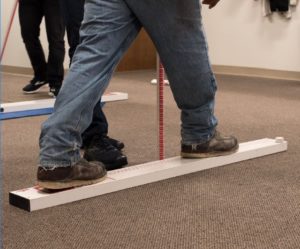Program Improves Worker Safety at Foss Shipyard
By Grant Johnson, Vice President, Health, Safety, Quality and Environment

Grant Johnson
Strains and sprains have long been considered a risk of working in a heavy industrial environment, but they do not have to be. The Foss Seattle Shipyard is taking these kinds of injuries seriously. We have recently partnered with a company called Vimocity, which is helping us identify new ways for workers to move to avoid these common types of injuries.

Functional Movement Screens evaluate individual employee movement patterns.
It is an important concern. Over the past five years, strains and sprains have accounted for almost a third of all injuries in the shipyard, and for half of all costs due to injury. Strains and sprains to the back, knee, shoulder and ankle cost the company hundreds of thousands of dollars each year, to say nothing of the pain and discomfort of our employees. If we are truly putting safety first as a company, then we need to address this problem.
Enter Vimocity. Vimocity is a company that seeks to treat the root cause of soft tissue injuries and chronic pain by helping people learn to move differently.
The Foss Seattle Shipyard began working with Vimocity in February with risk assessments and onsite observation sessions. They have since taught multiple workshops and have performed more than 100 Functional Movement Screens (FMS). These screens are evaluations of individual employee movement patterns, designed to identify ways for people to improve their movement and to reduce soft tissue injury. The FMS is scored on a rating of 1-21, with 14 or above being considered a great score, and a significantly reduced risk of injury. The shipyard is working toward an overall goal to exceed an FMS score of 14 or better.
Since implementing this program, shipyard staff have made impressive gains in their overall FMS score. Of the 54 employees who have so far performed both an initial and follow up FMS, Vimocity has noted an overall improvement in FMS score of 76 percent. This is a dramatic reduction in injury risk. Just as important, these employees have also reported a 76 percent reduction in instances of pain. People are feeling better.
